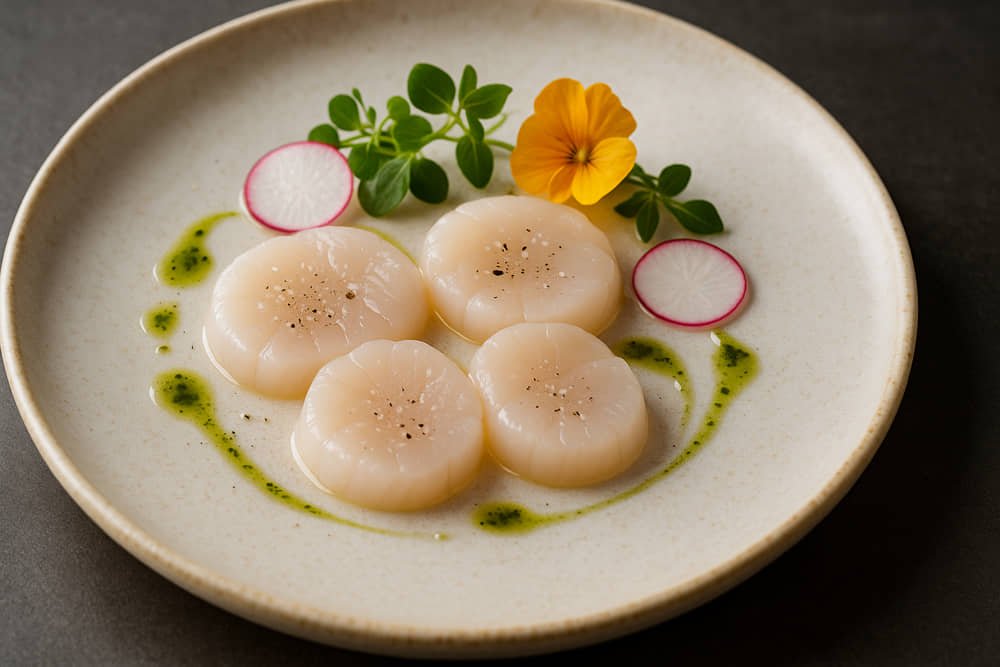Raw scallops have become a staple in fine dining restaurants around the world, not only for their delicate flavor but also for their ability to embody the essence of refined simplicity. Unlike heavily processed or sauced dishes, raw scallops rely on freshness, technique, and subtle pairings to create an elevated sensory experience. The moment a guest encounters a beautifully plated scallop crudo or sashimi, it sends a clear message: this is a dish crafted with precision, confidence, and restraint.
This growing popularity of raw scallops reflects a broader trend in luxury gastronomy — the pursuit of purity and authenticity. In a single bite, a perfectly prepared raw scallop can convey the terroir of the ocean, the philosophy of the chef, and the sophistication of the restaurant.
Contents
- 1 What Makes Scallops Suitable for Raw Preparation?
- 2 Sourcing Matters: Why Freshness Is Non-Negotiable
- 3 Raw Scallops as a Canvas for Culinary Artistry
- 4 Influence of Global Cuisines in Raw Scallop Dishes
- 5 Texture and Temperature: Crafting the Perfect Bite
- 6 Perceived Luxury and Menu Placement
- 7 Raw Scallops Beyond Tradition: Modern Interpretations
- 8 Challenges Chefs Face When Serving Raw Scallops
What Makes Scallops Suitable for Raw Preparation?
Not all seafood is suitable for raw consumption, but scallops stand out for several reasons. Their texture is naturally smooth and buttery, with a clean, slightly sweet flavor that requires minimal intervention. When served raw, scallops deliver a melt-in-your-mouth experience that rivals even the finest cuts of bluefin tuna or wagyu beef.
Additionally, scallops contain a high water content and low fat, making them ideal for raw applications like sashimi, carpaccio, and crudo. Their neutral yet refined taste also acts as a blank canvas, ready to absorb and enhance the flavors of citrus, herbs, oils, and seaweed — all common elements in fine dining plating.
Sourcing Matters: Why Freshness Is Non-Negotiable
In fine dining, ingredient quality is paramount, and for raw scallops, freshness isn’t just a preference — it’s a requirement. The best chefs source diver scallops directly from trusted suppliers or local fisheries, often choosing sashimi-grade options that meet strict food safety standards. These scallops are typically harvested and flash-frozen on the boat to preserve texture and minimize bacterial growth.
Beyond sourcing, maintaining a consistent cold chain from sea to plate is critical. Improper handling can compromise both safety and flavor. Many high-end kitchens invest in specialized refrigeration units and rigorous inspection processes to ensure every raw scallop served is pristine.
For readers interested in understanding how chefs identify and select the highest quality raw seafood, you can explore our in-depth guide: How to Choose Sashimi-Grade Seafood. This deeper look will help contextualize why sourcing decisions are so integral to the fine dining experience.
Raw Scallops as a Canvas for Culinary Artistry
At the highest levels of dining, presentation is more than aesthetics—it’s storytelling. Raw scallops offer chefs a pristine canvas upon which to craft visual masterpieces. Their pale, translucent color contrasts beautifully with vibrant garnishes such as microgreens, edible flowers, or ruby grapefruit pearls, resulting in plates that look like curated art.
But plating is only one layer of expression. Flavor pairings further demonstrate a chef’s creativity. Ingredients like yuzu kosho, white soy, burnt citrus oils, or fermented seaweed can be used in precise quantities to enhance, not overpower, the scallop’s natural sweetness. In fine dining, restraint and balance matter just as much as innovation. Raw scallops allow that finesse to shine, where even a single misplaced drop of sauce could shift the entire flavor profile.
Influence of Global Cuisines in Raw Scallop Dishes
Raw scallops may be served globally, but their treatment varies widely depending on culinary traditions. In Japanese cuisine, hotate sashimi is known for its elegant simplicity—thinly sliced scallops often paired with freshly grated wasabi, ponzu, or pickled shiso. The focus is on the purity of the scallop and minimal interference.
In contrast, Italian crudo introduces olive oil, citrus zest, and flaky sea salt to create a more Mediterranean expression of raw scallops. French-inspired preparations may lean toward delicate ceviches with white wine vinaigrette and fine herbs, often served in minimalist arrangements over crushed ice.
By borrowing from these diverse traditions, modern fine dining chefs craft unique cross-cultural interpretations—infusing their own identities into each dish while paying homage to culinary lineages that respect raw seafood.
Texture and Temperature: Crafting the Perfect Bite
Serving raw scallops is not as simple as slicing and plating. Texture and temperature play critical roles in delivering the ideal bite. Scallops are typically served slightly chilled—between 0°C and 5°C—to maintain firmness without numbing the palate. Too cold, and their buttery texture disappears; too warm, and the freshness fades.
Many chefs experiment with contrasting textures to create complexity in each bite. For example, pairing scallop slices with puffed rice, pickled seaweed stems, or crisp shallot crisps adds crunch to balance the silkiness. Acidity, fat, and even umami boosters like dashi or kombu can be layered in small doses to build depth.
The final bite is not just about taste, but mouthfeel—clean, soft, refreshing, and composed. When done right, it becomes a sensory journey that reflects the chef’s control over temperature, timing, and texture.
Perceived Luxury and Menu Placement
In fine dining, every menu item is strategically positioned—not just for flavor progression but also for psychological impact. Raw scallops, often featured as a first course or amuse-bouche, signal sophistication right from the start. Their presence early in the meal primes guests for a high-end experience, often served on bespoke dishware with minimal garnish to heighten the sense of exclusivity.
The perceived luxury of raw scallops isn’t just about rarity or price—it’s about presentation, sourcing, and restraint. Diners associate these dishes with freshness, elegance, and craftsmanship. As such, scallops are frequently priced above other appetizers, leveraging the psychological principle of anchoring: once a guest sees a $24 raw scallop starter, the $38 entrée seems more reasonable.
Many restaurants also reserve raw scallops for tasting menus, where they act as a transitional course between lighter raw offerings (like oysters or tuna tartare) and richer cooked proteins. In that context, their role is both sensory and structural.
Raw Scallops Beyond Tradition: Modern Interpretations
While traditional raw scallop dishes hold timeless appeal, many chefs today are breaking boundaries with avant-garde interpretations. In Nordic-inspired cuisine, scallops might be paired with cold-smoked cream, fermented cucumber, or dill oil foam—transforming familiar ingredients into new textural experiences. Some incorporate charred elements like leek ash or dehydrated miso to contrast the clean taste of raw scallops with deep umami.
Molecular gastronomy has also entered the scene, with chefs using techniques like flash-searing with a torch, infusing scallops with smoked seawater vapor, or plating them alongside spherified citrus beads. These innovations aren’t just for show—they engage diners intellectually, turning each bite into a dialogue between tradition and technology.
These modern takes not only reflect culinary evolution but also highlight the adaptability of raw scallops as an ingredient. Their mild profile allows them to absorb influences from any cuisine without losing their intrinsic elegance.
Raw Scallops Around the World: From Japanese Sashimi to French Ceviche is another great read that dives deeper into international influences on raw scallop dishes and their cultural evolution.
Challenges Chefs Face When Serving Raw Scallops
Despite their visual and gustatory appeal, raw scallops present several challenges in the kitchen. First and foremost is food safety. Because scallops are filter feeders, they can accumulate harmful bacteria or biotoxins if harvested from unsafe waters. Chefs must rely on certified suppliers and sashimi-grade labeling to ensure raw consumption is safe.
Another challenge is timing. Scallops must be prepared and served quickly after slicing to preserve texture and temperature. Leaving them too long on the plate—even under a heat lamp—can affect their structure. That’s why most fine dining restaurants have a specific station or cold line dedicated exclusively to raw prep.
Finally, raw scallops require technical precision. Unlike cooked seafood, there’s no opportunity to mask flaws with heat or seasoning. Every cut, garnish, and flavor pairing must be exact. For chefs, that means only the most skilled team members are trusted to handle raw service—further underscoring its status as a luxury component of the menu.
From minimalist sashimi slices to molecular reinterpretations, raw scallops have carved out a unique identity within the world of haute cuisine. Their elegance lies not only in taste and texture but also in the narrative they allow chefs to tell—of ocean provenance, restraint, creativity, and sensory balance.
As the fine dining landscape continues to evolve, raw scallops remain a benchmark of culinary confidence. They require impeccable sourcing, flawless technique, and a deep understanding of both tradition and innovation. In this way, they bridge the past and future of seafood gastronomy—anchored in purity but open to reinvention.
For readers exploring the broader role of raw seafood in gourmet culture, our feature on Global Raw Seafood Traditions You Should Know About highlights how different cultures around the world treat raw ingredients with reverence and technique. Or, for those interested in making confident seafood choices at home, don’t miss our practical guide on How to Choose Sashimi-Grade Seafood—a must-read for any home chef seeking to bring fine dining sensibilities to their own kitchen.
Raw scallops, at their best, are not just food. They are the first note in a symphony of flavor and detail—a moment of stillness before the crescendo of a well-curated meal.



